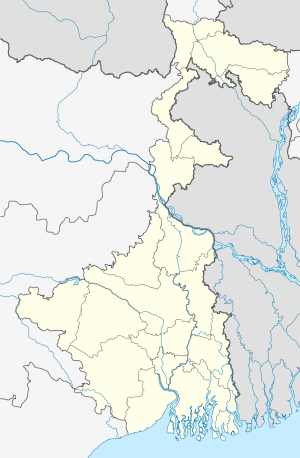Haripur, Bardhaman
| Haripur হরিপুর | |
|---|---|
| Town | |
 Haripur Location in West Bengal, India | |
| Coordinates: 23°41′00″N 87°11′50″E / 23.68336°N 87.197346°ECoordinates: 23°41′00″N 87°11′50″E / 23.68336°N 87.197346°E | |
| Country |
|
| State | West Bengal |
| District | Bardhaman |
| Elevation | 14 m (46 ft) |
| Population (2001) | |
| • Total | 6,888 |
| Languages | |
| • Official | Bengali, English |
| Time zone | IST (UTC+5:30) |
| PIN | 713378 |
| Telephone code | 91 341 667/668/669 |
| Lok Sabha constituency | Asansol |
| Vidhan Sabha constituency | Pandaveswar |
| Website |
bardhaman |
Haripur is a census town under Pandaveswar police station[1] of Durgapur subdivision in Bardhaman district in the Indian state of West Bengal.
Geography
Haripur is located at 23°41′00″N 87°11′50″E / 23.68336°N 87.197346°E.
The Asansol-Durgapur region is composed of undulating latterite soil. This area lies between two mighty rivers – the Damodar and the Ajay. They flow almost parallel to each other in the region – the average distance between the two rivers is around 30 km. For ages the area was heavily forested and infested with plunderers and marauders. The discovery of coal led to industrialisation of the area and most of the forests have been cleared.[2]
Tumni, a small stream, originates near Chichuria village in the area, flows parallel to the Ajay and joins it near Shyamarupagarh.[3]
Demographics
As of 2001 India census,[4] Haripur had a population of 6,888. Males constitute 54% of the population and females 46%. Haripur has an average literacy rate of 61%, higher than the national average of 59.5%: male literacy is 71%, and female literacy is 50%. In Haripur, 14% of the population is under 6 years of age. Even with such a less number of inhabitants, the place boasts of a Petrol Pump and a nationalised bank.
Economy
It is in the heart of the coal mining zone.[5]
Education
Haripur has three primary schools,[6] one Urdu primary school and one Madhyamik Sikha Kendra (MSK).
References
- ↑ District-wise list of stautory towns
- ↑ Chattopadhyay, Akkori, Bardhaman Jelar Itihas O Lok Sanskriti (History and Folk lore of Bardhaman District.), (Bengali), Vol I, pp 14-15, Radical Impression. ISBN 81-85459-36-3
- ↑ Chattopadhyay, Akkori, p. 36
- ↑ "Census of India 2001: Data from the 2001 Census, including cities, villages and towns (Provisional)". Census Commission of India. Archived from the original on 2004-06-16. Retrieved 2008-11-01.
- ↑ Chattopadhyay, Akkori, Bardhaman Jelar Itihas O Lok Sanskriti (History and Folk lore of Bardhaman District.), (Bengali) , Vol I, p 666, Radical Impression. ISBN 81-85459-36-3
- ↑ 7th All-India School Education Survey 2003